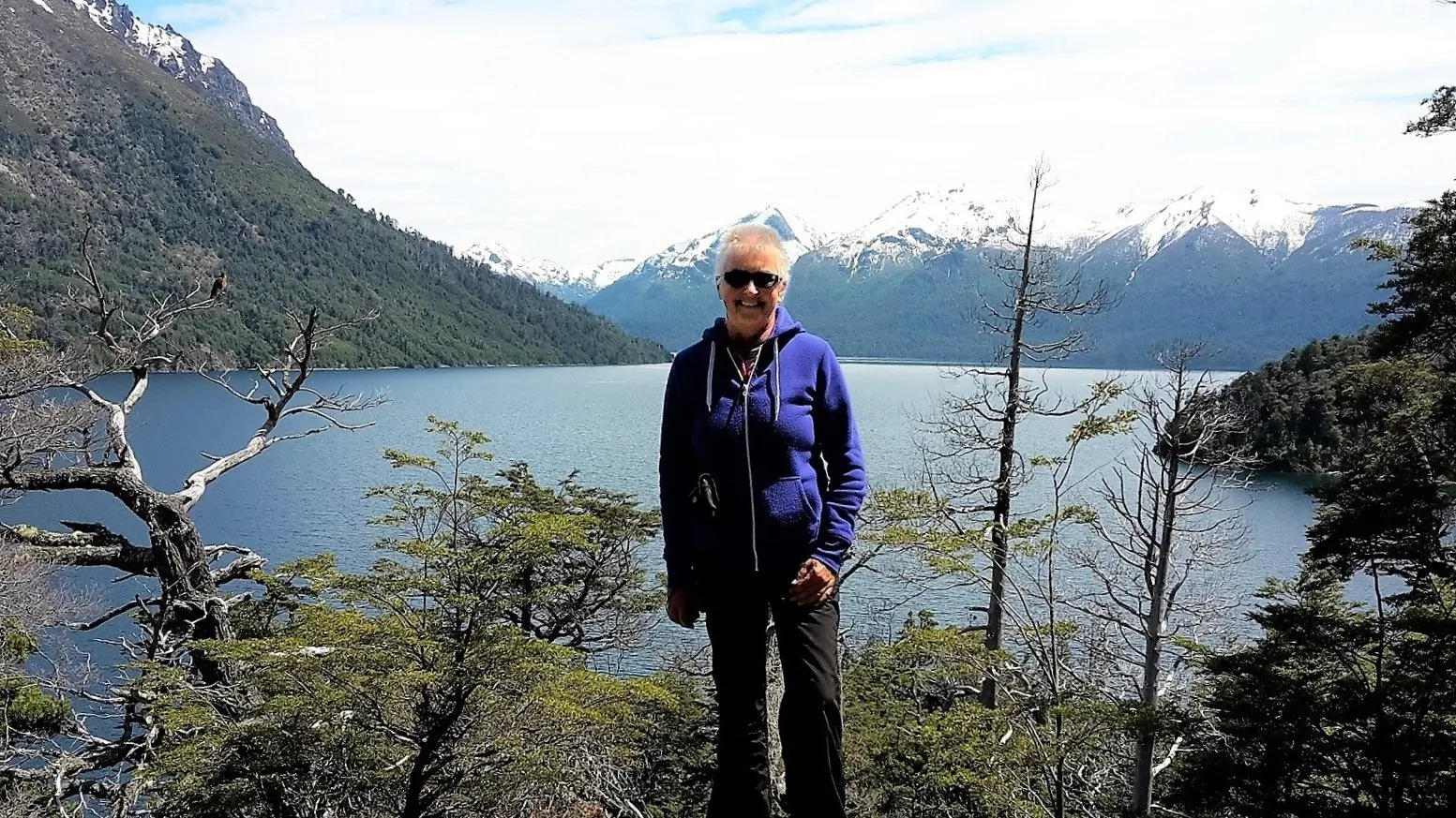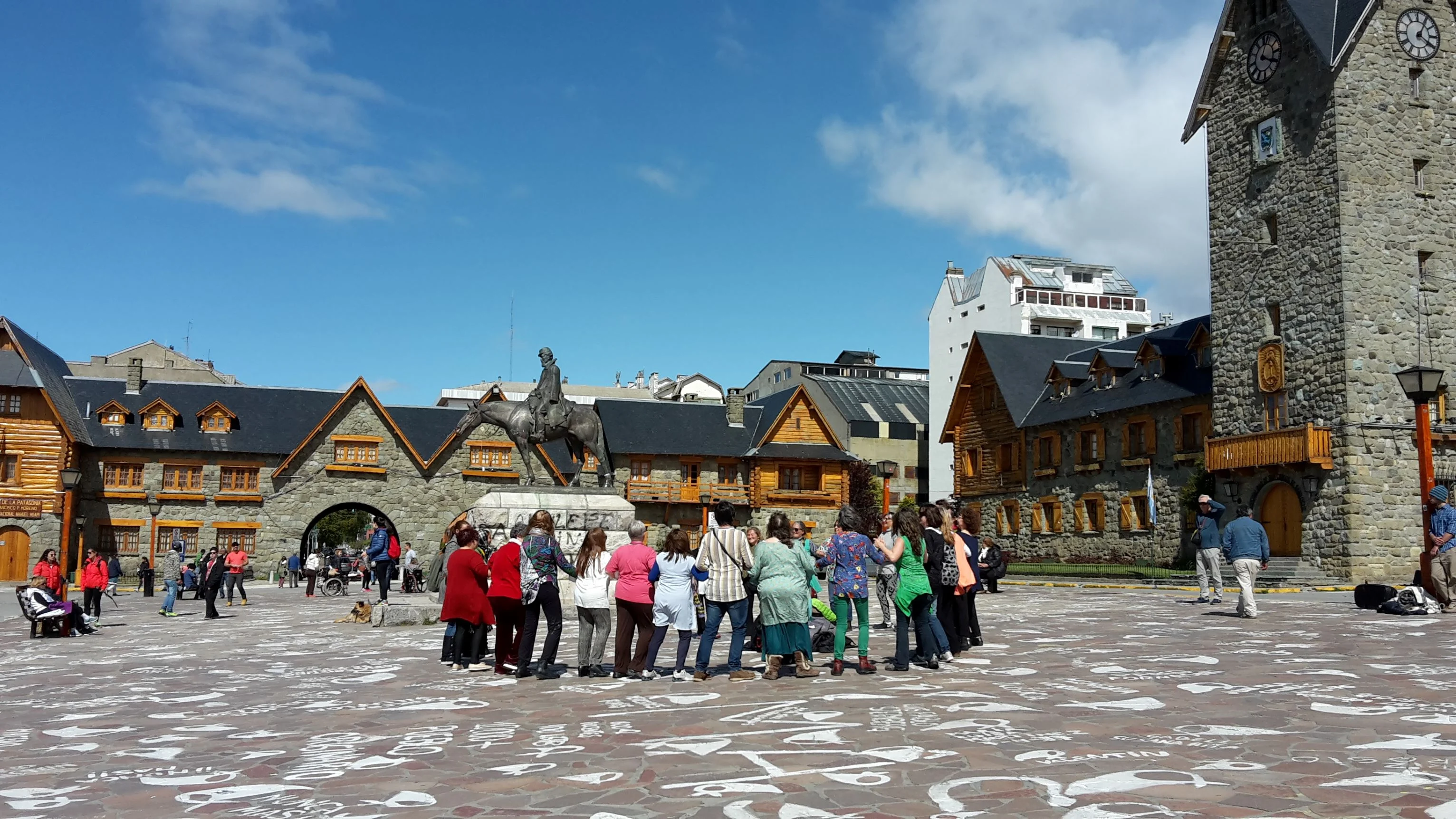We'd had a wonderful trip around the southern parts of Chilean Patagonia seeing some beautiful sights, then driven our motorhome Vdos to the Río Futaleufú International Border Pass and crossed into Argentina. We were aiming to drive Argentina's 7-lakes route (Ruta de los Siete Lagos), which was around 5 hours north of the border.
 |
| Marg in the Lakes District of Argentina |
But soon after leaving the border, we
saw signs to “Eco Camping” near Trevelin. We had originally planned to go further than Trevelin, but there was a huge tulip farm right next door to the camp, and the tulips were in bloom.
 |
| Tulips seen from our campsite near Trevelin, Argentinian Patagonia |
The camp was lovely, clean, well-organised, and in a vineyard. It had water, power and clean bathrooms
with hot showers - bliss when you are travelling! They even did casual food and made us a pizza for dinner, which we
enjoyed with their local wine.
We were keen to carry on to San Carlos de Bariloche (Bariloche) in Argentina's lakes district, as we'd heard it was a lovely alpine town built originally by German and Swiss immigrants. So following a peaceful night beside the tulips, we set off early the following morning.
After driving into the city through an industrial area and scruffy housing, we reached the charming city centre of Bariloche.
 |
| The historic town square of San Carlos de Baroloche, Argentinian Patagonia |
Located on Lago Nahuel Huapi, Bariloche has a lovely lakefront area and a well-preserved historic town square.
We visited the very helpful tourist office
there, and picked up some maps and camping information so we could stay in Bariloche.
Driving around the Lago we saw lots and lots of cabanas/holiday accommodation, but only one camp – Camping Petunia. We found a parking place there with a peek of the lake, but decided to move on the next day, as the facilities at Petunia were pretty dire.
 |
| Lago Nahuel Haupi, Argentinian Patagonia |
Driving west out of Bariloche the next morning, took us around Lago Nahuel Huapi and through the Nahuel Huapi National Park for some spectacular lake and mountain views.
Then we bumped our way on bad roads, into the small town of
Colonia Suiza. We found it to be very quaint and rustic, full of houses and shops built out of wood in the Swiss style. There were Swiss flags everywhere, further proclaiming its heritage.
We had a wonderful lunch of trout there, at a very
sweet little restaurant. The trout was fresh from the lake and simply cooked. It
tasted fabulous. Finding no other camps, we drove back to Camping Petunia for another night.
The next morning, we drove north on Ruta 40 along the 7-lakes route (Ruta de los Siete Lagos). It was a lovely drive, taking us alongside beautiful Lago Nahuel Huapi for much of the way.
We soon arrived in pretty Villa La Angostura, nestled between the mountains and the Lago.
Villa La Angostura turned out to be a very
lovely place. On the edge of town, we found the fabulous Camping Unquehue,
which was clean and well cared for. We happily settled down for a nice break, got heaps of washing done, and caught up with the blog etc.
A few days later, we explored the town, and bought some local and tasty food as
a treat. The weather was much warmer during the day than what we'd had over past weeks, which was really
enjoyable.
One day we walked down to Puerto Angostura on Lago Nahuel Huapi.
We were looking for a boat trip to the Los Arrayanes National Park which is on a peninsula off Puerto Angostura. The Park is home to a unique forest of ancient myrtle trees that we wanted to see, called Bosque de Arrayanes.
The local tourist companies there said
their boat trips were full, or didn't go until later in the day which meant we couldn't get a boat until later. We were quite disappointed as we'd walked for about 40 minutes to get there.
Then we saw a catamaran loading a group of
people, so we cheekily asked if they had room for two more. Despite the fact
their office said they were full, the captain let us on. Yaay!
Once in the National Park, we took the interesting circular walk through the most amazing coloured myrtle
trees. We'd only seen myrtle grown as a bush, but it seems
that here, they grow very tall, and are an interesting orange colour.
The way they have grown and their age, make
them unique in the world, and the area has been declared a national monument. Now, human activity there is restricted.
 |
| Villa La Angostura boat trip. View leaving Los Arrayanes National Park, Argentinian Patagonia |
A day or so later, we continued along Ruta 40 and the 7-lakes route with its beautiful scenery. Along the way, we stopped to admire several of the lakes.
 |
| Top (L-R): Lagos Correntoso & Espejo Grande. Below: Lagos Espejo Chico & Traful |
We liked the look Lago Correntoso, and saw busy fishermen there. Further along the route, we found Lago Espejo Grande, also known as the Mirror Lake.
Just up the road a bit was Lago Espejo Chico which had a nice beach, and at Lago Traful we stopped at the mirador (lookout) and had a wonderful view down to the distant mountains.
Overall, it was a very picturesque drive. We didn't see all of the lakes but stayed on paved roads to manage it as a day trip. So, after Lago Traful, we turned back to the south again.
 |
| Lago Nahuel Huapi on the 7-Lakes Route, heading to the Argentina-Chile border |
We headed south in order to get to the border to
cross back into Chile, as we wanted to visit the lakes there.
However, on the Argentinian side, instead of the quick border crossing
we had come to expect from our experience further south, we came across a very large queue of cars. It eventually took us 3 hours to complete the
customs process. As a young Argentinian guy in the queue said "It's South
America!"
Once through, we drove up and over the Cardenal Antonia Samore Pass which crosses the Andes Mountains.
This was an incredible drive. We wound our way
higher and higher, with lots of snow on both sides of the road, to see great
views of the towering Andes peaks, and many rivers and waterfalls. It was truly spectacular.
Reaching the Chilean border post after about
39 kms over the mountains, we encountered another queue. Fortunately, this one only took us
half-an-hour to clear.
However, our half-dozen fresh eggs, which we
had forgotten to boil, were confiscated in the fresh food check!
Then we were off again, traveling much later
than anticipated, towards our next stop, the Chilean lakes district.
The above blog is part of our 4-month tour of South America. The first blog on this tour is called "Buenos Aires here we come".






